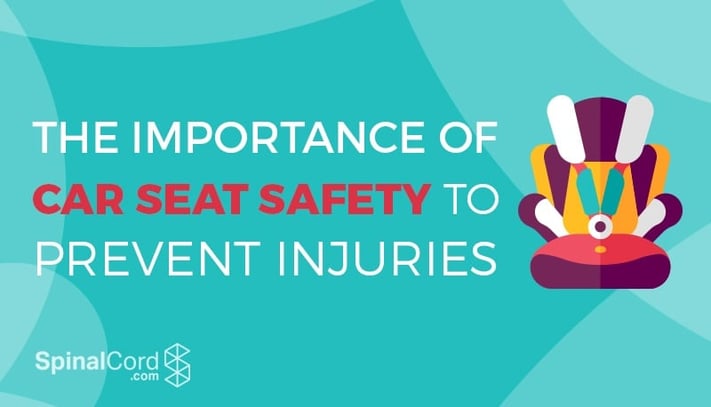The Importance of Car Seat Safety to Prevent Injuries

Every new parent has struggled with a car seat, and many report that their car seat battles leaving them questioning their own competence. Don't give up the fight. Those few moments you spend doing battle with a pile of plastic and metal really can save your child's life. Car accidents are a leading cause of death and serious injuries among small children, but car seats reduce the risk of death in an accident by 54%. In 2004, car seats saved 451 lives. One of those 451 could be your child this year, so take the time to master car seat safety and make it your religion.
How Car Seats Save Children
If you have heard it once, you've probably heard it a thousand times: “No one wore car seats in my day, and we all turned out ok.” But anecdote is not data. There are more cars on the road, driving at faster speeds for longer distances, than ever before. This makes the roads of today significantly more dangerous than those of just 20 years ago. Data from the National Highway Traffic Safety Administration points to a 67% reduction in the risk of serious injuries when parents put their children in well-fitted car seats.
Your child's body is not as durable as your own. Much of a baby's skeleton is made of soft cartilage that will eventually turn into bone. This makes her more vulnerable to injuries during a crash, particularly since her organs are not as well-protected as those of an adult. Some other factors that make car crashes particularly dangerous for children include:
- Developing brains and spinal cords; brain and spinal cord damage are more dangerous in children, whose brains and bodies are still developing.
- Children's smaller size, which makes it easier for even a relatively light bump to your car to send them flying.
- Children's lower self-control; an adult knows to sit still in his or her seat. But your child may squirm in his car seat or booster seat if he is not properly secured, making him more vulnerable if you get into a crash.
Why a Good Car Seat Is Not Enough
Many parents spend endless months researching their new baby's car seat, only to install it and then completely forget about it for months—or even years. While a good car seat is vital for protecting your child in the event of a crash, it is not enough on its own. Even the best car seats cannot force you to properly install them or buckle your child in, so be sure to check for these common errors:
- A car seat that is either too big or too small for your child, offering less security.
- An improperly positioned car seat; even a secure, quality car seat will offer only limited protection to a newborn in the front seat of the car or who is facing forward.
- A car seat base that is not flush against the seat and securely fastened.
- A car seat that is not fully and securely attached to its base.
- Car seat buckles that are not fully buckled, or that are too loose to provide any real protection.
Why Do Parents Incorrectly Use Car Seats (or Not Use Them at all)?
As with most parenting mistakes, few parents make car seat errors because they want to hurt their children. In most cases, they simply don't understand the severity of the risk they are accepting. But car accidents are common, and almost everyone will experience one at some point. There are more than 10 million accidents each year, with 3 in 1,000 producing fatalities. For children, accidents are even more dangerous, since it takes very little force to send a child flying forward through a windshield.
Some parents are unwilling to fight with their older children over car seats, and tell themselves that an ill-fitting car seat is better than no car seat at all. But in some cases, a car seat that doesn't fit is actually more dangerous, because your child can become trapped in the straps or strangle when she slips downward. Buckle your child every time. Not only is it the law; it is the single most important thing you can do to keep your child safe.
Rules for Car Seat Safety
If you want to do all you can to protect your child from death, serious injury, and trauma after a car crash, follow these simple tips:
- Keep your child in a rear-facing car seat until she is at least 24 months old, or until she exceeds the weight recommended by the seat manufacturer. Keeping your child rear-facing through age three offers even more safety benefits, so don't rush your little one to graduate to a forward-facing seat too quickly.
- Children should remain in a car seat with a harness until age seven.
- Children ages 8-12 will likely need booster seats to remain safe.
- Children should not sit in the front seat until they weigh more than 90 pounds.
- Children should not sit in any seat that has an air bag until they weigh more than 90 pounds, so ask your mechanic about deactivating any rear airbags you have.
- Put car seats in the back seat of the car. The center seat is statistically the safest location, but side seats are acceptable if you have multiple car seats or your middle seat does not have an appropriate buckle.
- The car seat base should be fully secure, and flush against the seat. If it rocks or moves, it is incorrectly installed. Your local fire department can help you install the seat. Some pediatricians also offer assistance with car seat installation.
- The straps should fit snugly against your child's body, with the buckle flush against your child's chest—not at his stomach or chin. If you can pinch the harness straps together, it's too loose.
- If the seat has two buckles, both must be buckled at all times.
- Your child should not be permitted to move the shoulder strap under her arm or unbuckle a portion of the car seat.
Check online regularly to see if your child's car seat has been recalled, and read car seat reviews before selecting a brand. Remember also that car seats expire six years from the date of manufacture, so a used car seat may be safe, but a car seat from three children ago likely won’t be. Check the label on the car seat for an expiration date. If no such label is visible, don't use it.
Stay Updated on Advancements On Traumatic Brain &
Spinal Cord Injuries
About the Author





